Methods of locomotion performed by animals vary with their habitats and the demand of the situation. However, locomotion is generally for search of food, shelter, mate, suitable breeding grounds, favourable climatic conditions or to escape from enemies/predators.
Cells of the human body exhibit three main types of movements, namely, amoeboid, ciliary and muscular.
Some specialised cells in our body like macrophages and leucocytes in blood exhibit amoeboid movement. It is effected by pseudopodia formed by the streaming of protoplasm (as in Amoeba). Cytoskeletal elements like microfilaments are also involved in amoeboid movement.
Ciliary movement occurs in most of our internal tubular organs which are lined by ciliated epithelium. The coordinated movements of cilia in the trachea help us in removing dust particles and some of the foreign substances inhaled alongwith the atmospheric air. Passage of ova through the female reproductive tract is also facilitated by the ciliary movement.
Movement of our limbs, jaws, tongue, etc, require muscular movement. The contractile property of muscles are effectively used for locomotion and other movements by human beings and majority of multicellular organisms. Locomotion requires a perfect coordinated activity of muscular, skeletal and neural systems. In this chapter, you will learn about the types of muscles, their structure, mechanism of their contraction and important aspects of the skeletal system.
You have studied in Chapter 8 that the cilia and flagella are the outgrowths of the cell membrane. Flagellar movement helps in the swimming of spermatozoa, maintenance of water current in the canal system of sponges and in locomotion of Protozoans like Euglena. Muscle is a specialised tissue of mesodermal origin. About 40-50 per cent of the body weight of a human adult is contributed by muscles. They have special properties like excitability, contractility, extensibility and elasticity. Muscles have been classified using different criteria, namely location, appearance and nature of regulation of their activities. Based on their location, three types of muscles are identified : (i) Skeletal (ii) Visceral and (iii) Cardiac.
Skeletal muscles are closely associated with the skeletal components of the body. They have a striped appearance under the microscope and hence are called striated muscles. As their activities are under the voluntary control of the nervous system, they are known as voluntary muscles too. They are primarily involved in locomotory actions and changes of body postures.
Visceral muscles are located in the inner walls of hollow visceral organs of the body like the alimentary canal, reproductive tract, etc. They do not exhibit any striation and are smooth in appearance. Hence, they are called smooth muscles (nonstriated muscle). Their activities are not under the voluntary control of the nervous system and are therefore known as involuntary muscles. They assist, for example, in the transportation of food through the digestive tract and gametes through the genital tract.
As the name suggests, Cardiac muscles are the muscles of heart. Many cardiac muscle cells assemble in a branching pattern to form a cardiac muscle. Based on appearance, cardiac muscles are striated. They are involuntary in nature as the nervous system does not control their activities directly.
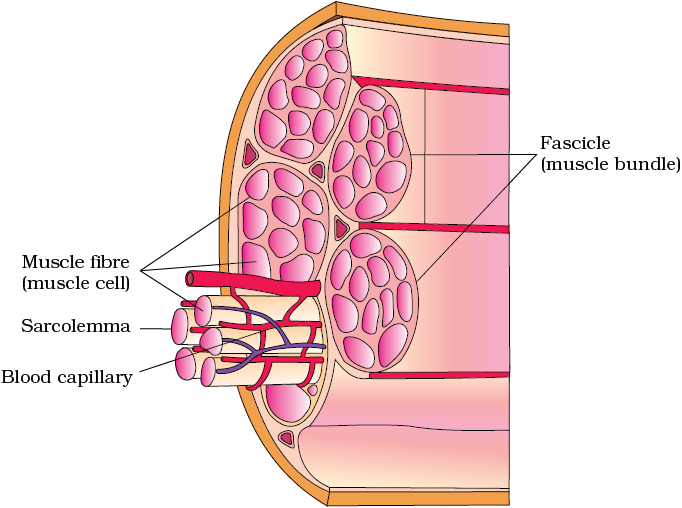
Let us examine a skeletal muscle in detail to understand the structure and mechanism of contraction. Each organised skeletal muscle in our body is made of a number of muscle bundles or fascicles held together by a common collagenous connective tissue layer called fascia. Each muscle bundle contains a number of muscle fibres (Figure 20.1). Each muscle fibre is lined by the plasma membrane called sarcolemma enclosing the sarcoplasm. Muscle fibre is a syncitium as the sarcoplasm contains many nuclei. The endoplasmic reticulum, i.e., sarcoplasmic reticulum of the muscle fibres is the store house of calcium ions. A characteristic feature of the muscle fibre is the presence of a large number of parallelly arranged filaments in the sarcoplasm called myofilaments or myofibrils. Each myofibril has alternate dark and light bands on it. A detailed study of the myofibril has established that the striated appearance is due to the distribution pattern of two important proteins – Actin and Myosin. The light bands contain actin and is called I-band or Isotropic band, whereas the dark band called ‘A’ or Anisotropic band contains myosin. Both the proteins are arranged as rod-like structures, parallel to each other and also to the longitudinal axis of the myofibrils. Actin filaments are thinner as compared to the myosin filaments, hence are commonly called thin and thick filaments respectively. In the centre of each ‘I’ band is an elastic fibre called ‘Z’ line which bisects it. The thin filaments are firmly attached to the ‘Z’ line. The thick filaments in the
‘A’ band are also held together in the middle of this band by a thin fibrous membrane called ‘M’ line. The ‘A’ and ‘I’ bands are arranged alternately throughout the length of the myofibrils. The portion of the myofibril between two successive ‘Z’ lines is considered as the functional unit of contraction and is called a sarcomere (Figure 20.2). In a resting state, the edges of thin filaments on either side of the thick filaments partially overlap the free ends of the thick filaments leaving the central part of the thick filaments. This central part of thick filament, not overlapped by thin filaments is called the ‘H’ zone.

Each actin (thin) filament is made of two ‘F’ (filamentous) actins helically wound to each other. Each ‘F’ actin is a polymer of monomeric ‘G’ (Globular) actins. Two filaments of another protein, tropomyosin also run close to the ‘F’ actins throughout its length. A complex protein Troponin is distributed at regular intervals on the tropomyosin. In the resting state a subunit of troponin masks the active binding sites for myosin on the actin filaments (Figure 20.3a).

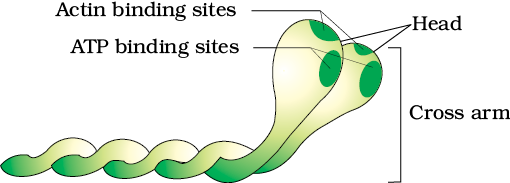
(b)
Figure 20.3 (a) An actin (thin) filament (b) Myosin monomer (Meromyosin)
Each myosin (thick) filament is also a polymerised protein. Many monomeric proteins called Meromyosins (Figure 20.3b) constitute one thick filament. Each meromyosin has two important parts, a globular head with a short arm and a tail, the former being called the heavy meromyosin (HMM) and the latter, the light meromyosin (LMM). The HMM component, i.e.; the head and short arm projects outwards at regular distance and angle from each other from the surface of a polymerised myosin filament and is known as cross arm. The globular head is an active ATPase enzyme and has binding sites for ATP and active sites for actin.
Mechanism of muscle contraction is best explained by the sliding filament theory which states that contraction of a muscle fibre takes place by the sliding of the thin filaments over the thick filaments.
Muscle contraction is initiated by a signal sent by the central nervous system (CNS) via a motor neuron. A motor neuron alongwith the muscle fibres connected to it constitute a motor unit. The junction between a motor neuron and the sarcolemma of the muscle fibre is called the neuromuscular junction or motor-end plate. A neural signal reaching this junction releases a neurotransmitter (Acetyl choline) which generates an action potential in the sarcolemma.
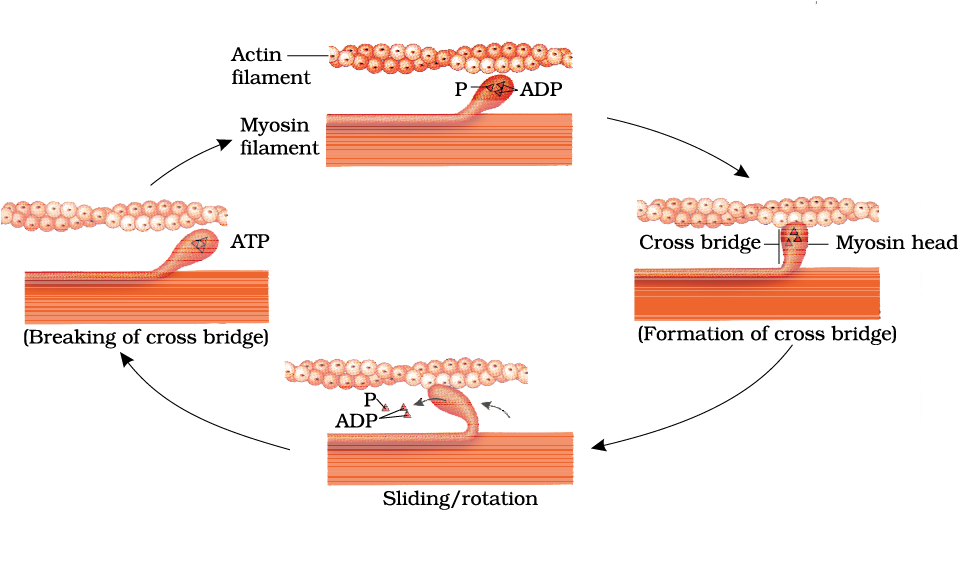 Figure 20.4 Stages in cross bridge formation, rotation of head and breaking of cross bridge
Figure 20.4 Stages in cross bridge formation, rotation of head and breaking of cross bridge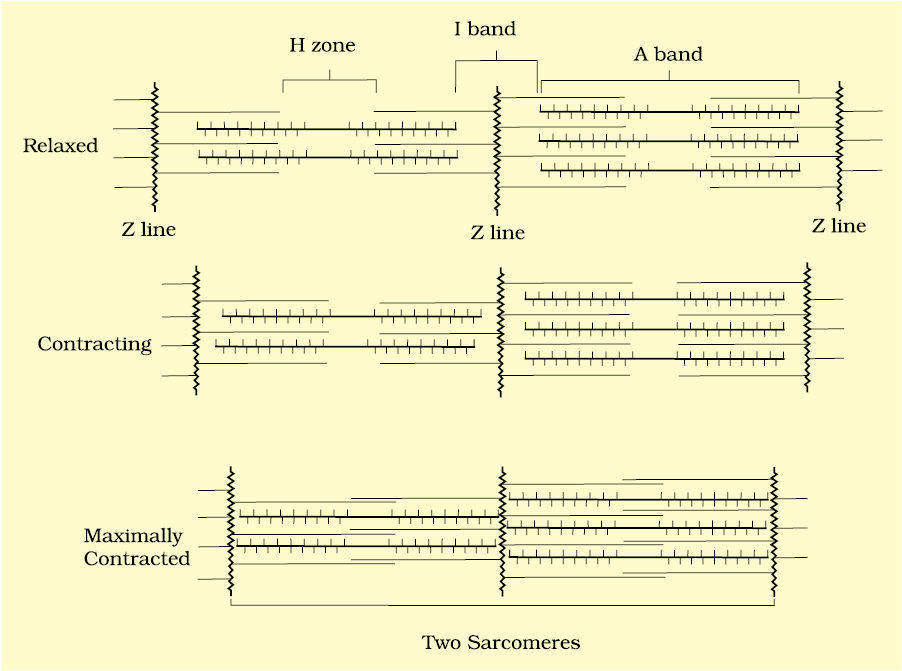
Skeletal system consists of a framework of bones and a few cartilages. This system has a significant role in movement shown by the body. Imagine chewing food without jaw bones and walking around without the limb bones. Bone and cartilage are specialised connective tissues. The former has a very hard matrix due to calcium salts in it and the latter has slightly pliable matrix due to chondroitin salts. In human beings, this system is made up of 206 bones and a few cartilages. It is grouped into two principal divisions – the axial and the appendicular skeleton.
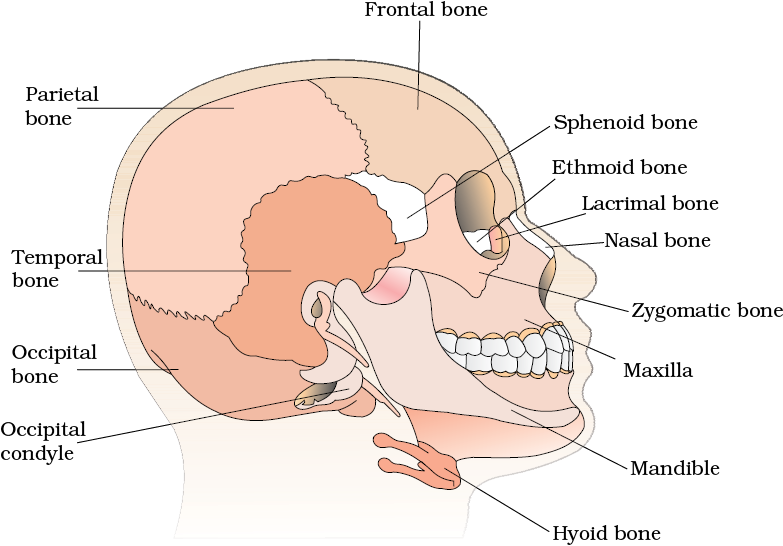
Axial skeleton comprises 80 bones distributed along the main axis of the body. The skull, vertebral column, sternum and ribs constitute axial skeleton. The skull (Figure 20.6) is composed of two sets of bones – cranial and facial, that totals to 22 bones. Cranial bones are 8 in number. They form the hard protective outer covering, cranium for the brain. The facial region is made up of 14 skeletal elements which form the front part of the skull. A single U-shaped bone called hyoid is present at the base of the buccal cavity and it is also included in the skull. Each middle ear contains three tiny bones – Malleus, Incus and Stapes, collectively called Ear Ossicles. The skull region articulates with the superior region of the vertebral column with the help of two occipital condyles (dicondylic skull).
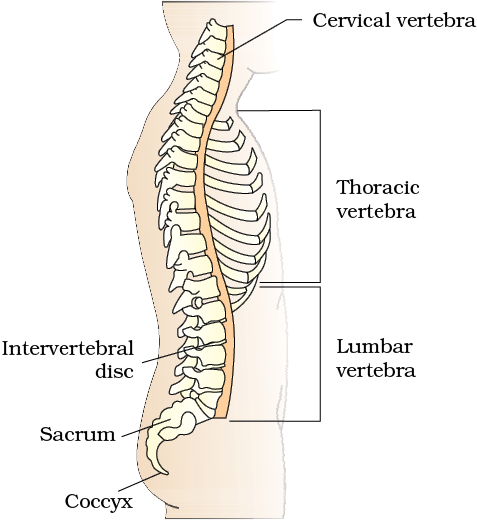
Our vertebral column (Figure 20.7) is formed by 26 serially arranged units called vertebrae and is dorsally placed. It extends from the base of the skull and constitutes the main framework of the trunk. Each vertebra has a central hollow portion (neural canal) through which the spinal cord passes. First vertebra is the atlas and it articulates with the occipital condyles. The vertebral column is differentiated into cervical (7), thoracic (12), lumbar (5), sacral (1-fused) and coccygeal (1-fused) regions starting from the skull. The number of cervical vertebrae are seven in almost all mammals including human beings. The vertebral column protects the spinal cord, supports the head and serves as the point of attachment for the ribs and musculature of the back. Sternum is a flat bone on the ventral midline of thorax.
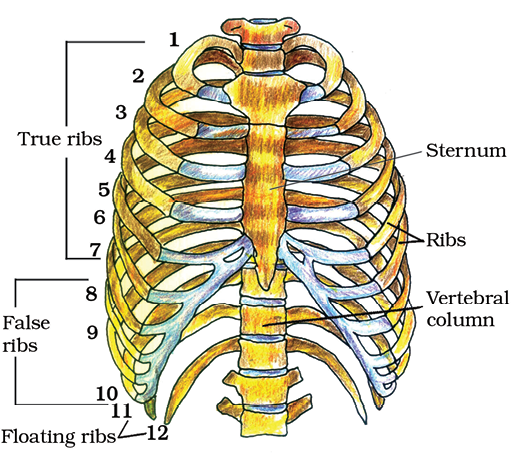
The bones of the limbs alongwith their girdles constitute the appendicular skeleton. Each limb is made of 30 bones. The bones of the hand (fore limb) are humerus, radius and ulna, carpals (wrist bones – 8 in number), metacarpals (palm bones – 5 in number) and phalanges (digits – 14 in number) (Figure 20.9). Femur (thigh bone – the longest bone), tibia and fibula, tarsals (ankle bones – 7 in number), metatarsals (5 in number) and phalanges (digits – 14 in number) are the bones of the legs (hind limb) (Figure 20.10). A cup shaped bone called patella cover the knee ventrally (knee cap).
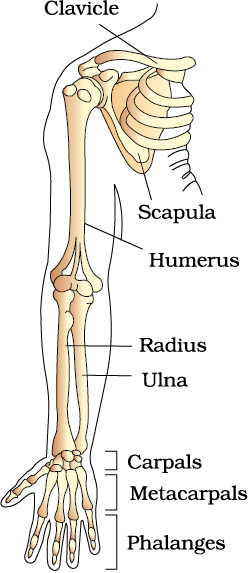

Figure 20.10 Right pelvic girdle and lower limb bones (frontal view)
Pectoral and Pelvic girdle bones help in the articulation of the upper and the lower limbs respectively with the axial skeleton. Each girdle is formed of two halves. Each half of pectoral girdle consists of a clavicle and a scapula (Figure 20.9). Scapula is a large triangular flat bone situated in the dorsal part of the thorax between the second and the seventh ribs. The dorsal, flat, triangular body of scapula has a slightly elevated ridge called the spine which projects as a flat, expanded process called the acromion. The clavicle articulates with this. Below the acromion is a depression called the glenoid cavity which articulates with the head of the humerus to form the shoulder joint. Each clavicle is a long slender bone with two curvatures. This bone is commonly called the collar bone.
Pelvic girdle consists of two coxal bones (Figure 20.10). Each coxal bone is formed by the fusion of three bones – ilium, ischium and pubis. At the point of fusion of the above bones is a cavity called acetabulum to which the thigh bone articulates. The two halves of the pelvic girdle meet ventrally to form the pubic symphysis containing fibrous cartilage.
Joints are essential for all types of movements involving the bony parts of the body. Locomotory movements are no exception to this. Joints are points of contact between bones, or between bones and cartilages. Force generated by the muscles is used to carry out movement through joints, where the joint acts as a fulcrum. The movability at these joints vary depending on different factors. Joints have been classified into three major structural forms, namely, fibrous, cartilaginous and synovial.
Fibrous joints do not allow any movement. This type of joint is shown by the flat skull bones which fuse end-to-end with the help of dense fibrous connective tissues in the form of sutures, to form the cranium.
In cartilaginous joints, the bones involved are joined together with the help of cartilages. The joint between the adjacent vertebrae in the vertebral column is of this pattern and it permits limited movements.
Synovial joints are characterised by the presence of a fluid filled synovial cavity between the articulating surfaces of the two bones. Such an arragement allows considerable movement. These joints help in locomotion and many other movements. Ball and socket joint (between humerus and pectoral girdle), hinge joint (knee joint), pivot joint (between atlas and axis), gliding joint (between the carpals) and saddle joint (between carpal and metacarpal of thumb) are some examples.
Myasthenia gravis: Auto immune disorder affecting neuromuscular junction leading to fatigue, weakening and paralysis of skeletal muscle.
Muscular dystrophy: Progressive degeneration of skeletal muscle mostly due to genetic disorder.
Tetany: Rapid spasms (wild contractions) in muscle due to low Ca++ in body fluid.
Arthritis: Inflammation of joints.
Osteoporosis: Age-related disorder characterised by decreased bone mass and increased chances of fractures. Decreased levels of estrogen is a common cause.
Gout: Inflammation of joints due to accumulation of uric acid crystals.
Movement is an essential feature of all living beings. Protoplasmic streaming, ciliary movements, movements of fins, limbs, wings, etc., are some forms exhibited by animals. A voluntary movement which causes the animal to change its place, is called locomotion. Animals move generally in search of food, shelter, mate, breeding ground, better climate or to protect themselves.
The cells of the human body exhibit amoeboid, ciliary and muscular movements. Locomotion and many other movements require coordinated muscular activities. Three types of muscles are present in our body. Skeletal muscles are attached to skeletal elements. They appear striated and are voluntary in nature. Visceral muscles, present in the inner walls of visceral organs are nonstriated and involuntary. Cardiac muscles are the muscles of the heart. They are striated, branched and involuntary. Muscles possess excitability, contractility, extensibility and elasticity.
Muscle fibre is the anatomical unit of muscle. Each muscle fibre has many parallelly arranged myofibrils. Each myofibril contains many serially arranged units called sarcomere which are the functional units. Each sarcomere has a central ‘A’ band made of thick myosin filaments, and two half ‘I’ bands made of thin actin filaments on either side of it marked by ‘Z’ lines. Actin and myosin are polymerised proteins with contractility. The active sites for myosin on resting actin filament are masked by a protein-troponin. Myosin head contains ATPase and has ATP binding sites and active sites for actin. A motor neuron carries signal to the muscle fibre which generates an action potential in it. This causes the release of Ca++ from sarcoplasmic reticulum. Ca++ activates actin which binds to the myosin head to form a cross bridge. These cross bridges pull the actin filaments causing them to slide over the myosin filaments and thereby causing contraction. Ca++ are then returned to sarcoplasmic reticulum which inactivate the actin. Cross bridges are broken and the muscles relax.
Repeated stimulation of muscles leads to fatigue. Muscles are classified as Red and White fibres based primarily on the amount of red coloured myoglobin pigment in them.
Bones and cartilages constitute our skeletal system. The skeletal system is divisible into axial and appendicular. Skull, vertebral column, ribs and sternum constitute the axial skeleton. Limb bones and girdles form the appendicular skeleton. Three types of joints are formed between bones or between bone and cartilage – fibrous, cartilaginous and synovial. Synovial joints allow considerable movements and therefore, play a significant role in locomotion.
Question 1:
Draw the diagram of a sarcomere of skeletal muscle showing different regions.
Question 2:
Define sliding filament theory of muscle contraction.
Question 3:
Describe the important steps in muscle contraction.
Question 4:
Write true or false. If false change the statement so that it is true.
(a)Actin is present in thin filament
(b)H-zone of striated muscle fibre represents both thick and thin filaments.
(c) Human skeleton has 206 bones.
(d)There are 11 pairs of ribs in man.
(e) Sternum is present on the ventral side of the body.
NEETprep AnswerQuestion 5:
Write the difference between:
(a) Actin and Myosin
(b) Red and White muscles
(c) Pectoral and Pelvic girdle
NEETprep AnswerQuestion 6:
Match Column I with Column II:
Question 7:
What are the different types of movements exhibited by the cells of human body?
Question 8:
How do you distinguish between a skeletal muscle and a cardiac muscle?
Question 9:
Name the type of joint between the following:
(a) atlas/axis
(b) carpal/metacarpal of thumb
(c) between phalanges
(d) femur/acetabulum
(e) between cranial bones
(f) between pubic bones in the pelvic girdle
NEETprep AnswerQuestion 10:
Fill in the blank spaces:
(a)All mammals (except a few) have __________ cervical vertebra.
(b)The number of phalanges in each limb of human is __________
(c) Thin filament of myofibril contains 2 ‘F’ actins and two other proteins namely __________ and __________.
(d) In a muscle fibre Ca++ is stored in __________
(e) __________ and __________ pairs of ribs are called floating ribs.
(f) The human cranium is made of __________ bones.
NEETprep Answer
1. Match the following columns.
Column I |
Column II |
|
A. Fast muscle fibres B. Slow muscle fibres C. Actin filament D. Sarcomere |
1. Myoglobin 2. Lactic acid 3. Contractile unit 4. I-band
|
Codes
A B C D
(a) 1 2 4 3
(b) 2 1 3 4
(c) 2 1 4 3
(d) 3 2 4 1
NEETprep Answer
2. Ribs are attached to
(a) scapula
(b) sternum
(c) clavicle
(d) ilium
NEETprep Answer
3. What is the type of movable joint present between the atlas and axis?
(a) Pivot
(b) Saddle
(c) Hinge
(d) Gliding
NEETprep Answer
4. ATPase of the muscle is located in
(a) actinin
(b) troponin
(c) myosin
(d) actin
NEETprep Answer
5. Intervertebral disc is found in the vertebral column of
(a) birds
(b) reptiles
(c) mammals
(d) amphibians
NEETprep Answer
6. Which one of the following is showing the correct sequential order of vertebrae in the vertebral column of human beings?
(a) Cervical — lumbar — thoracic — sacral — coccygeal
(b) Cervical — thoracic — sacral — lumbar — coccygeal
(c) Cervical — sacral — thoracic — jumbar — coccygeal
(d) Cervical — thoracic — lumbar — sacral — coccygeal
NEETprep Answer
7. Which one of the following pair is incorrect?
(a) Hinge joint — between humerus and pectoral girdle
(b) Pivot joint — between atlas, axis and occipital condyle
(c) Gliding joint — between the carpals
(d) Saddle joint — between carpel and metacarpals of thumb
NEETprep Answer
8. Knee joint and elbow joints are examples of
(a) saddle joint
(b) ball and socket joint
(c) pivot joint
(d) hinge joint
NEETprep Answer
9. Macrophages and leucocytes exhibit
(a) ciliary movement
(b) flagellar movement
(c) amoeboid movement
(d) gliding movement
NEETprep Answer
10. Which one of the following is not a disorder of bone?
(a) Arthritis
(b) Osteoporosis
(c) Rickets
(d) Atherosclerosis
NEETprep Answer
11. Which one of the following statement is incorrect?
(a) Heart muscles arestriated and involuntary
(b) The muscles of hands and legs are striated and voluntary
(c) The muscles located in the inner walls of alimentary canal are striated and involuntary
(d) Muscles located in the reproductive tracts are unstriated and involuntary
NEETprep Answer
12. Which one of the following statements is true?
(a) Head of humerus bone articulates with acetabulum of pectoral girdle.
(b) Head of humerus bone articulates with glenoid cavity of pectoral girdle.
(c) Head of humerus bone articulates with a cavity called acetabulum of pelvic girdle.
(d) Head of humerus bone articulates with a glenoid cavity of pelvic girdle
NEETprep Answer
13. Muscles with characteristic striations and involuntary are
(a) muscles in the wall of alimentary canal
(b) muscles of the heart
(c) muscles assisting locomotion
(d) musclesof the eyelids
NEETprep Answer
14. Match the following columns.
Column I |
Column II |
|
A. Sternum B. Glenoid cavity C. Freely movable joint D. Cartilagenous joint |
1. Synovial fluid 2. vertebrae 3. Pectoral girdle 4. Flat bones |
Codes
A B C D
(a) 2 1 3 4
(b) 4 3 1 2
(c) 2 1 4 3
(d) 4 1 2 3
NEETprep Answer
15. Name thecells/tissues in human body which
(a) exhibit amoeboid movement
(b) exhibit ciliary movement
NEETprep Answer
16. Locomotion requires a perfect coordinated activity of muscular ......... systems.
NEETprep Answer
17. Sarcolemma, sarcoplasm and sarcoplasmic reticulum refer to particular type of cell in our body. Which is this cell and to what parts of that cell do these names refer to?
NEETprep Answer
18. Label the different components of actin filament in the diagram given below

NEETprep Answer
19. The three tiny bones present in middle ear are called ear ossicles. Write them in correct sequence beginning from ear drum.
NEETprep Answer
20. Whatis the difference between the matrix of bones and cartilage?
NEETprep Answer
21. Which tissue is afflicted by myasthenia gravis? What is the underlying cause.
NEETprep Answer
22. How do our bone joints function without grinding noise and pain?
NEETprep Answer
23. Give the location of a ball and socket joint in a human body
NEETprep Answer
24. Our forearm is made of three different bones. Comment.
NEETprep Answer
25. With respect to rib cage, explain the following
(a) bicephalic ribs
(b) true ribs
(c) floating ribs
NEETprep Answer
26. In old age, people often suffer from stiff and inflamed joints. What is this condition called? What are the possible reasons for these symptoms?
NEETprep Answer
27. Exchange of calcium between bone and extracellular fluid takes place under the influence of certain hormones
(a) What will happen if more of Ca2+ is in extracellular fluid?
(b) What will happen if very less amount of Ca2+ is in the extracellular fluid?
NEETprep Answer
28. Name atleast two hormones which result in fluctuation of Ca2+ level.
NEETprep Answer
29. Rahul exercises regularly by visiting a gymnasium. Of late he is gaining weight. What could be the reason? Choose the correct answer and elaborate.
(a) Rahul has gained weight due to accumulation of fats in body
(b) Rahul has gained weight due to increased muscle and less of fat
(c) Rahul has gained weight because his muscle shape has improved
(d) Rahul has gained weight because he is accumulating water in the body
NEETprep Answer
30. Radha was running on a treadmill at a great speed for 15 minutes continuously. She stopped the treadmill and abruptly came out. For the next few minutes, she was breathing heavily/fast. Answer the following questions.
(a) What happened to her muscles when she did strenuously exercised?
(b) How did her breathing rate change?
NEETprep Answer
31. Write a few lines about gout.
NEETprep Answer
32. What is the source of energy for muscle contraction?
NEETprep Answer
33. What are the points for articulation of pelvic and pectoral girdles?
NEETprep Answer
34. Calcium ion concentration in blood affects muscle contraction. Does it lead to tetany in certain cases? How will you correlate fluctuation in blood calcium with tetany?
NEETprep Answer
35. An elderly women slipped in the bathroom and had severe pain in her lower back. After X-ray examination doctors told her it is due to a slipped disc. What does that mean? How does it affect our health?
NEETprep Answer
36. Explain sliding filament theory of muscle contraction with neat sketches.
NEETprep Answer
37. How does a muscle shorten during its contraction and return to its original form during relaxation?
NEETprep Answer
38. Discuss the role of Ca2+ ions in muscle contraction. Draw neat sketches to illustrate your answer.
NEETprep Answer
39. Differentiate between pectoral and pelvic girdle.
NEETprep Answer